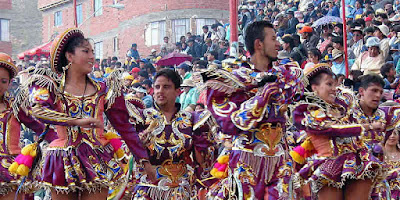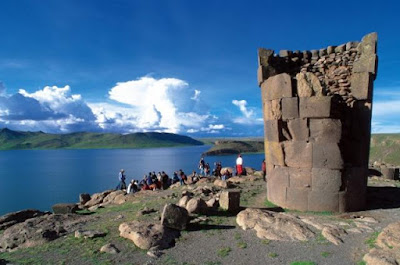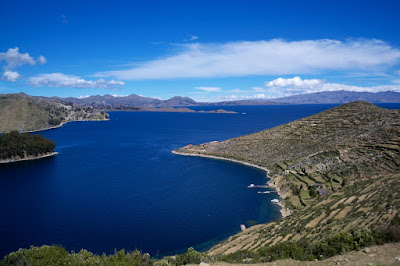Monday, April 4, 2016
Fiesta de la Candelaria
PunoFiesta de la Candelaria. Puno folk Capital of Peru and America
Feast of the Virgen de la Candelaria
Considered as the folkloric Capital of Peru and America, Puno is immensely rich in dance, music, customs and legends. Puno is famous for the varied and colorful folklore, certainly the richest and stunning the continent, whose maximum expression is the feast of the Virgin of Candelaria, which takes place in February.
During the month of February, in the early days, Puno has become the "Capital folk of the Peru and America". The streets are overrun by faithful, by dancers in colorful costumes and even tourists that pay homage to the patron saint of the city: the Virgen de La Candelaria, known as La Candelaria Mamacha total love and devotion you Puno residents have. It puts you saw of faith and is wrapped in a Carnival party, becoming one of the largest religious celebrations of the country from the colonial era to the present day.
Mamacha Candelaria is accompanied by a crowd that prays, thanks and asks miracles. Many times, even pieces of paper are thrown you filled with prayers, and in the streets, the altars are prepared to honor it.
The feast of Candlemas takes sixteen days, begins on February 2 with the masses, for meeting groups and musicians; then starts the first procession, and the Mamacha is accompanied by, a crowd that prays, thanks and asks miracles. Many times, even pieces of paper are thrown you filled with prayers, and in the streets, the altars are prepared to honor it. It is a ceremony full of excitement and joy. The Virgin Mary is visited by people from various places, which is attached to this event, the next day, people parade through the streets, with amazing costumes, music and dancing. This parade, over the years, has become a contest of folk dances with the participation of hundreds of dancers and musicians, who delight in their dances to thousands of spectators from all over the world. At the end of the contest, the party becomes still larger and everyone involved in it. It is an unforgettable experience.
Here you can see the famous Diablada. The image of the Virgin is carried in procession through the main streets of the city of Puno. The days are fairs and festivals in different neighborhoods where drinking and dancing during the day and night. The apotheosis of the festival is on February 12 when hundreds of groups showed their respect with dances in a long procession through the town, accompanied by typical music of the Andes.
Other traditions say that on that same occasion, during the morning procession, the palanquin of the Virgin began to shine with great intensity, encegueciendo to the besiegers and making them victims of a terrible Mirage: a huge army horse filled the city and their arms shone also intensely. Before that vision, Túpac Catari troops retreated.
Inside and in the surroundings of Puno is 726 the number of registered dances which have passed the test of time and that they are still practiced for this Puno is the folkloric Capital of Peru and America.
Sillustani Puno
PunoSillustani Puno. Chulpas of Sillustani
The cemetery of Sillustani chullpas ninety constructed as circular towers of stone, where it was buried to the authorities of the town of el Collao. This archaeological complex, located on the shores of Lake Umayo, consists of almost 90 chullpas or ayawasis (of the dead) built homes with large carved blocks of stone extracted from two nearby quarries.
Archaeological site located 34 kilometers from the capital. One of the largest necropolises in the world, and that rises to 4,000 meters above sea level on an Esplanade surrounded by beautiful Lake Umayo. The chullpas of Sillustani are gigantic funerary monuments built by the Colla; they are quadrangular and circular buildings exceeding 12.
The Chullpas of Sillustani are located on top of a hill overlooking Lake Umayo. Apparently here buried nobles, leaders or priests who were then revered, why your preferred site.
The paved road that links Puno and Juliaca should be taken to get to Sillustani.
Altitude: 3,950 meters above sea level. Address: 34 km (45 min) n of Puno
Taquile island
PunoTaquile Island, rural tourism on the dream island of Taquile-Puno
The inhabitants of the island of Taquile in Titicaca Lake are of quechua origin and are characterized by the roots of their traditions, customs and colorful costumes. Engaged in fishing, agriculture and the production of textiles. The island of Taquile Puno has rural tourism ventures that allow you to spend a few days in the homes of residents learning the local customs.
Taquile, 35 km from Puno by boat, it is the dream Island, in this place you won't find hotels, roads, electricity, cars and even bicycles or dogs, bulla, only a warm attention - services are given in casa de los comuneros - and the opportunity to live in a lovely, with imposing background Lake surroundings.
The visit to the island of Taquile in a day can only be quite tiring, because the journey by boat and on the 533 steps which climb to the village. The pre-Inca terraces and small ruins delimit the terrain and the numerous passages that will be so busy.
Taquile - 1,200 Indians - community is very cozy and tourism has not yet modified nor a little the way of life of the inhabitants of another era, dressed in traditional costumes and that they speak only Quechua. It is an island that has managed to preserve a great ethnic and cultural value as well as the traditions of craftsmanship and its world famous textiles.
To get you must split of the Puno Bay. Boats leave every day between 7 and 9 a.m.
Altitude: 3,808 meters above sea level. Address: 35 km (45 min) or Puno
Uros Island
PunoIslands Uros floating, islands of reeds of Lake titicaca. Uros community Chulluni
The Uros island is one of the most famous islands of Lake Titicaca, located 6 km from the port of Puno and 3.812 m.a.s.l. is just an amazing Archipelago of 40 islands of totora (kind of Reed that grows in the swamps of South America), inhabited by the Uros, descendants of one of the oldest cultures of the continent. The origin of the Uro people got lost in the labyrinths of history, but it is presumed that they are descended from the Pukinas, one of the oldest communities of America. This floating community men claim to be the owners of the waters of Lake Titicaca.
The floating islands of the uros are actually not precisely Islands, non-floating, or uros who inhabit them. It is in fact constructions of totora that sit in the bed of the Lake, and its inhabitants are Aymara origin - the last uro died in the 1950s.
Current Aymara population possesses the skill to make constructions of totora on Lake Titicaca bedding. Grouped in lathe to the Uros-Chulluni community offer rural tourism that allows the traveler to stay in the Islands and participate in the daily activities of the Communards. To reach them, you must take a boat in the Bay of Puno.
The Reed is a resource renewable and is essential for the life of the Uros, since with it they built their islands. The totora, woven skillfully, is also the ceilings, walls and doors of their homes. With the same material made the main means of transportation between the Islands and the Mainland: the rafts. Another use of the reeds, which is very important, is that when the stems dry use them as firewood to their kitchens, fulfilling the function of fuel. With the advent of tourism, they began to make beautiful crafts of reeds, which sold to help in its economy. They also use it as food, since removed the crust is a white, fibrous, virtually without taste, but also used substance as a complement to their diets.
Altitude. 3,808 meters above sea level. Address: 6 km from the port of Puno
Islands of Lake Titicaca
PunoIslands of Lake Titicaca: Uros and Taquile, Amantani, Anapia and Suasi
FLOATING ISLANDS OF THE UROS
The floating islands of the uros are actually not precisely Islands, non-floating or uros who inhabit them. It is in fact constructions of totora that sit in the bed of the Lake, and its inhabitants are Aymara origin - the last uro died in the 1950s. Grouped in lathe to the Uros-Chulluni community offer rural tourism that allows the traveler to stay in the Islands and participate in the daily activities of the Communards.Altitude. 3,808 meters above sea level. Address: 6 km from the port of Puno.
TAQUILE
The inhabitants of the island of Taquile are of quechua origin and are characterized by the roots of their traditions, customs and colorful costumes. Engaged in fishing, agriculture and the production of textiles. The island of Taquile has rural tourism ventures that allow you to spend a few days in the homes of residents learning the local customs.Altitude: 3,808 meters above sea level. Address: 35 km (45 min) or Puno
AMANTANI
3,808 meters above sea level. 40 km NW of Puno (1 h)Amantani island is ideal for get away from everything which is even more gentle than its neighbor Taquile. The island boasts tourist services and is highly recommended for removal, since it is little frequented. The island lies off the peninsula of Capachica and is inhabited by four thousand people divided in eight farming communities. Its inhabitants engaged in agriculture and crafts, whose objects include textiles and carved in stone. This island offers natural viewpoints and some archaeological remains: Pacha Tata and Pacha Mama, left by the Tiahuanaco culture, such as ceremonial centers and a cemetery of mummies. The island has two natural viewpoints and archaeological sites as source Tiahuanaco.
ANAPIA ARCHIPELAGO
3,808 meters above sea level. 111 km (3 h) NW of PunoTucked away in the lower lake or Winaymarka, the islands forming the archipelago Anapia - Yuspique, Patahuata, sauna, Ccaño and Anapia - offer you a different way to do tourism, from the hands of its own people, who have formed a company of ecotourism that will allow you to visit this wonderful place.
ISLA SUASI
This island, in the middle of Lake Titicaca belongs to a nature lover called Martha Giraldo, Puno born in the town of rust, which several years ago had a small eco-hostel, decided to turn it into the most peculiar and beautiful Highland place. Suasi is an island of all, a refuge for those who want to isolate themselves from the city. There and do not have telephones, TV, neither cars nor electricity. Everything works with solar energy. It is a good place to read, surrounded by incredible scenery, at the foot of the Lake and under a clean blue sky. Also is you can take walks, view alpacas and vicuñas, boating or enjoy a massage at the lodge. The hotel is managed by the national chain Casa Andina, company that has operated the facilities of the hotel.Suasi is accessed from the Cambria village, 118 km north of Puno by unpaved road or 2.5 hours of trip across Lake from Puno's main port.
TITIKAYAK
This is the name of an activity undertaken in the Lake Titicaca. In Llachon, offers this ride in a kayak, sail along the Lake and appreciating the nature of the place.TOTORA
Speaking of Titicaca and its islands is to speak of a persistent plant that you given to many of the inhabitants of the Lake the tools necessary to live: cattails (Scyrpus Reed). With its fiber, it is possible to build boats, houses, fishing and cooking utensils, and even the ground where people live. Finally, the totora is food for men and animals and an important source of protein.SILLUSTANI
The cemetery of Sillustani chullpas ninety constructed as circular towers of stone, where it was buried to the authorities of the town of el Collao. This archaeological complex, located on the shores of Lake Umayo, consists of almost 90 chullpas or ayawasis (of the dead) built homes with large carved blocks of stone extracted from two nearby quarries.Altitude: 3,950 meters above sea level. Address: 34 km (45 min) n of Puno
Lake Titicaca
PunoLake Titicaca, the boating lake tourism more high in the world.
Shortly before dawn on Lake Titicaca, a blue haze covers our view and prevents us from looking clearly to our around. Anxious about the cold and calm that precedes the light, dozens of wild Guinea Pigs they scurry through the rocks and the ichu grown from the shore. Lost among the cattails, a small seven colours begins his day with a song short and fearful; the ducks and the collide break the silence of the waters with a sudden stroke of their wings, just when the first ray of sunlight touches the top of a nearby hill. As if it were an act of magic, the fog disappears between the Golden flashes of the reeds and the waters of the Lake begin to reflect the intense blue of the sky serrano. A new day has begun in Lake Titicaca.
Lake Titicaca in Puno at 3,808 meters and a surface near the 8,200 km2 - of which 4,700 are in territory Peru - Lake Titicaca is the highest navigable lake in the world and is, without doubt, the symbol of Puna identity. Lake Titicaca in its deepest part, alongside Island Soto in Peru, reaches 280 meters and has a volume of approximately 840 cubic kilometers and a length of 1,150 km, more than 30 Islands banks. Watershed that forms Lake Titicaca has the length of almost 60 thousand km2 stretching on the plateau of the Collao, in the middle of Eastern and Western Andes cordilleras.
The importance of Lake Titicaca transcends geographical and historical qualities cobra particular value in logical terms to act as a regulator of temperature in the surrounding areas and source of income for the inhabitants of the Highlands. The Cattail communities growing in their waters are a key element in the survival of an important diversity of birds such as the yanavicos (Plegadis ridgwayi), the sietecolores of the reeds (Tachuris rubrigastra), the neotropic (Phleocryptes melanops), the moorhens (Gallinula chloropus), the coot (Fulica ardesiaca), as well as several species of ducks (Anatidae).
The open waters of Lake Titicaca are the habitat of the flamingos (Phoenicopterus chilensis) and an endemic species of the Lake: the Lake Titicaca Grebe (Rollandia microptera). Its frozen Fund is also home to 14 species of fish of the genus Oresuas, commonly called carachi, and Lake Titicaca frog (Telmatobius culeus), a species of great size that uses the long folds of your body to retain scarce oxygen possessing waters.
Threats on the waters of Lake Titicaca
Currently, Lake Titicaca must face the consequences of population growth and the explosive development of the city of Puno, which even pour their wastewater into the Lake without pretreatment. This problem adds the erosion of the banks to causes of overgrazing and indiscriminate logging and the introduction of alien fauna in the waters that preys on the resources of the native species carrying them and extinction, as it is the case for the mackerel and trout that compete with native species such as the ispis and carachi. Nearly 20 thousand hectares of totoral have been lost because of pollution and drought, and the waters of the Bay are covered with lentejilla, a plant that forms a dense green mat that prevents the arrival of light in the Lake and therefore, the process of photosynthesis.To curb these problems required the conclusion of all the actors involved in the conservation of the great Lake: local governments, municipalities, tourism entrepreneurs and villagers themselves. Only in this way they can preserve the biodiversity of these waters for the future.
Protected area: the Titicaca national reserve
In order to protect part of this natural richness of the Titicaca national reserve was created in October 1978, about 36.180 hectares divided into two sectors: Ramis, located in the province of Huancane, at the north end of the Lake; and the sector of the Bay of Puno, near the departmental capital.The Titicaca Grebe
The waters of Lake Titicaca are home to an endemic species (that only develops in this place): the diver of Titicaca (Rollandia Microptera), a bird unable to fly, very similar to a duck, but with pointed beak and small wings that feeds mainly on fish which capture plunging into the icy waters of the Lake to a depth of 100 meters.The titicaca Grebe can measure up to 40 cm and has a yellowish-brown color, but on the ventral side of white color. Tends to build floating nests in dense areas of the totoral which lays its eggs with shell blue. Currently vulnerable due to loss of habitat, poaching and the collection of eggs, and is protected in both sectors
Subscribe to:
Comments (Atom)






